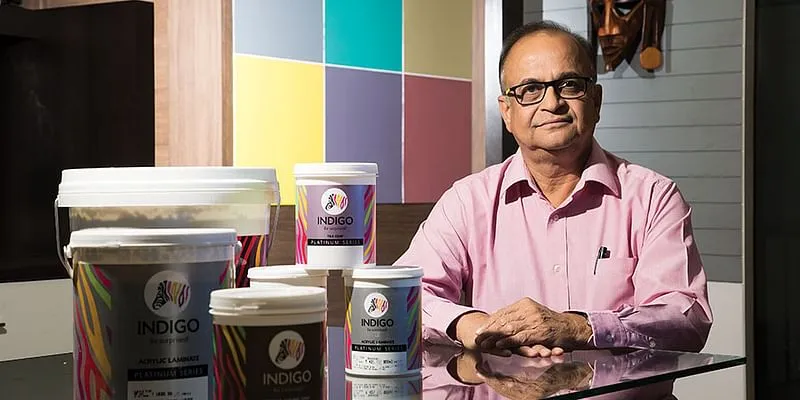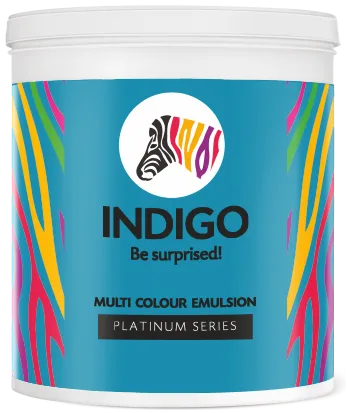Starting with Rs 1 lakh, this chemical engineer built a Rs 625Cr revenue brand and took it to IPO: the story of Indigo Paints
Hemant Jalan’s Indigo Paints had a modest beginning in 2000. A small chemical unit in Patna and an industrial shed in Jodhpur served as the foundation for the company. In FY20, the business reported revenues of Rs 625 crore, and in FY21, it went public.
Chemical engineer Hemant Jalan’s early days as the founder of were quite different from his life before entrepreneurship.
While working with Sterlite and heading its copper smelter unit in Tamil Nadu, Hemant used to take a private jet to business meetings. After starting his own business, he travelled between cities by two-tier AC train.
Started in 2000 with Rs 1 lakh, Hemant’s company Indigo Paints had a modest beginning. In his words, the company was established with “practically no capital investment.” A small chemical unit in Patna and an industrial shed in Jodhpur served as the foundation for the company in its early years.
“We started by making lower-end cement paints, and gradually expanded our range to cover most segments of water-based paints such as exterior emulsions, interior emulsions, distempers, primers, etc. We began spreading our footprint across the country and rapidly expanded our reach,” Hemant says.
Employing a customer-driven focus on innovation and an incentive-based approach to sales, Hemant has led Indigo to become one of India’s largest paint brands.
In FY20, the Pune-headquartered business reported revenues of Rs 625 crore with a net profit of Rs 48 crore. At present, the company has three manufacturing facilities located in Rajasthan, Kerala, and Tamil Nadu. Indigo recently went public and listed on the NSE and BSE.

Hemant Jalan, founder and MD, Indigo Paints (image credit: Forbes India)
In a candid interview with SMBStory, Hemant narrates how he took his small cement paint business and turned it into a household name.
Edited excerpts from the interview:
SMBStory [SMBS]: How did you go from running a large copper smelter to becoming an entrepreneur?
Hemant Jalan [HJ]: Early in my career, I worked with my Patna-based family business, which was into trading and distributing gas stoves and electrical insulators. I also started a chemical unit in Patna, but it suffered a setback in 1995, and I moved on.
I joined Sterlite in 1996, and I worked my way up to heading the copper smelter unit in Tamil Nadu. But in 1999, I took the tough decision of parting ways with Sterlite in Tuticorin and moving to Pune. I was 42 at the time, and that’s not the best age to start an entrepreneurial venture.
A friend was running a management consultancy and was looking for a partner. I took the plunge and worked with him for a year. This period gave me time to reflect and think of starting my own paint company in 2000.
SMBS: How did you get the idea to start a paint manufacturing company?
HJ: I was still running a small chemical unit in Patna. The plant made the industrial chemical calcium chloride, which was a minor chemical used in cement paint. We used to send it to cement paint makers. On the whole, the chemical plant generated around Rs 1.5 crore annual turnover.
One day, while at the Patna office, I saw and met several small-scale manufacturers who were running cement paint units. They were all doing well for themselves. I thought to myself that if they can do well in paints, so can we!
However, Bihar or the nearby state of Jharkhand were not good locations to start making paints as the raw materials had to come from Jodhpur. So I put up an advertisement in Jodhpur, looking for an industrial shed for rent. Once I finalised a shed there, I started making lower-end cement.
The business did reasonably okay — we did around Rs 80 lakh in sales in the first year. Then, we began diversifying into water-based paints and entered one state a year for marketing our products.

Indigo Paints' interior emulsion paint
SMBS: What is the secret to Indigo Paints’ expansion?
HJ: An Indigo Paints salesman in Kerala once asked me what reward he would get if he made Rs 1 crore worth of sales in a year. I asked him what he wanted, and he said he wanted a Hero Honda motorbike. I agreed.
Incredibly, the man achieved the target and received the reward. I increased his target to Rs 1.5 crore and told him I’d give him a Tata Nano if he achieved it.
This interaction led me to realise that there was a great power in incentivising our sales force. In 2009, when we were a Rs 12 crore business, we held an annual conference for our team and set up an incentivisation programme for them. We let them choose their targets, and agreed to reward them disproportionately higher if they succeeded.
The team started setting high targets for themselves, and this changed the course of the business. We started seeing 50 percent yearly growth, and our manpower attrition dropped to almost zero.
SMBS: How did you finance your expansion?
HJ: As we boosted our production, we took bank loans to finance our working capital and expansion requirements. In 2014, Sequoia came on board with Rs 50 crore investment and made us debt-free.
We could take aggressive bets in marketing and shift from cheaper newspaper advertisements to expensive TV ads. We were also able to acquire a mid-size paint company in Kerala. Sequoia invested another Rs 90 crore in us and increased their stake from 21 percent to 39 percent.
In 2018, we onboarded MS Dhoni as our brand ambassador. He has been an important catalyst to take our story to the country and increase our brand equity. Dhoni and Indigo Paints are seen synonymously as a small-town boy who made it big in the country through patience, grit, and perseverance.
SMBS: Indigo sells paint products directly to customers, and does not use a B2B approach. Why?
HJ: As we are into manufacturing, marketing, distribution, and sales of decorative paints, we have a large number of SKUs. However, there are usually not many B2B stockists or distributors in the paint business.
Brands have to sell directly to retailers through company-operated depots. The value maximisation thus happens by selling to retailers directly. Further, our strength lies in branding and marketing, and so, it makes more sense to target our customers directly.
We have retail touchpoints across 11,000 active dealers who are serviced through strategically located depots. We also engage actively with painters. We educate and enable painters, polishers, and contractors through monthly workshops.
SMBS: Who are your competitors? How is the company staying ahead of them?
HJ: Across the board, we compete with decorative paint manufacturing companies. While there are well-established national players, there are also strong regional players. We believe that innovation is the only way to stay ahead of the curve.
Unlike most other companies, ours is not a lab-driven innovation. We listen to customer requirements keenly, and then design our products to cater to their functional needs. That’s how we were able to develop an arsenal of differentiated products.
Further, most other companies have various sub-brands to target customers across price points. But at Indigo Paints, the products are sold under the same brand across different series, such as the Platinum series (luxury segment), Gold series (mid-segment), Silver and Bronze series (economy segment).
SMBS: What were your thoughts behind taking Indigo Paints public? Why go for an IPO?
HJ: We had three reasons for the IPO. The first was to create an exit route for our VC investors. The second was to fund our capex and expansion. We are raising around Rs 300 crore through the IPO. We want to deploy Rs 150 crore for a new manufacturing unit in Pudukkottai, Tamil Nadu, to enhance our water-based paint manufacturing capacity.
We also need to finance the accelerated deployment of tinting machines in the dealer network, repay residual debt, finance issue expenses, and the general corporate reserve.
The third reason was related to our ESOP policy. We have a liberal ESOP policy that keeps our employees motivated, and helps us in retaining talent. Listing the company gives the ESOP holders a transparent exit option.
SMBS: How did COVID-19 affect the business, and what was done to address it?
HJ: Like all other companies, our operations were shut down during the lockdown. While we restarted manufacturing operations at all of our manufacturing facilities with the progressive relaxation of the lockdown in May 2020, we had implemented additional safety measures, such as regular temperature checks, sanitisation, compulsory use of masks and hand sanitisers, and limited workforce.
The paint industry, in general, has bounced back quickly, and Indigo has recovered sharply due to our strong presence in Tier III and IV cities and rural areas. Our sales have surpassed pre-COVID levels.
SMBS: What are the future plans for the company?
HJ: We are going to continue with our existing strategy, which has yielded good results. We are expanding our portfolio of differentiated products, adding to our dealer network in small towns and large cities, and continuing to add tinting machines.
We will do sustained advertising to further strengthen the brand, draw level with some larger paint manufacturers in the dealer network, and look to improve our profitability parameters.
Edited by Suman Singh








